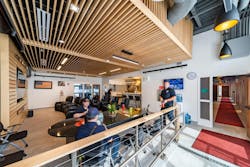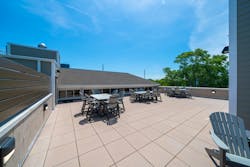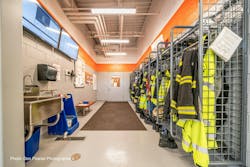Benefits of Innovative Spaces in Today's Fire Stations
The world of first responders is changing with new technologies, facilities, and challenges, but also fewer resources available to them. Electric vehicle (EV) and battery energy storage system (BESS) fires continue to make headlines as firefighters race to develop better strategies and tactics to battle them. Burnout rises as the number of volunteers falls. Climate change and civil unrest have tragic consequences in communities across the country. Through all of this, a fire station needs to be a resource and tool to help first responders rise to the challenge. This requires innovation.
Innovative spaces can take on a variety of unique and non-traditional forms. They don’t need to take up a lot of space, or even be a formal space, but they have important purposes and benefits, including mental and physical health, training, resiliency, and recruitment and retention.
Mental and physical health
The importance of mental and physical health cannot be understated. Anything less than peak condition is a hazard to each first responder and the community. Protecting health shouldn’t be a burden, though. Carcinogenic contamination is one of the top health risks on first responders’ mind, as many stations already have transition zones and decontamination spaces to keep potential contaminants out of the living and administrative areas. This has been a positive movement within the industry for several years and is recognized by the NFPA 1585: Standard for Exposure and Contamination Control.
An innovative design adaptation would take the space as defined in this standard and design it into required pathways of travel. Square footage is at a premium and every bit is working against your budget. Taking the decontamination (DeCon) features and working them into a transition corridor eliminates a separate room with doors and clearances that all take up space. A bonus is that the transition corridor is part of the primary path of travel. This means the DeCon amenities will be readily available and highly visible to remind first responders to use them and develop a safer, cleaner culture in the station.
Another innovation in contamination control is to move the decontamination facilities outside of the station entirely. This may include an exterior DeCon room, which can only be accessed from the exterior as apparatus return to the station, or a separate DeCon facility that may not be on the same site as the station. One way to save on redundant spaces, budget, and remove contaminants from the station completely, is to have a common facility where apparatus and personnel can decon after an incident, and then return to their respective station. This concept works well for departments with multiple stations and numerous apparatus.
As for physical health, a small plot of land can become an herb or vegetable garden to support healthy eating, reduce grocery costs, and promote communal meals. Biophilic design and “green walls” can connect people to nature and help reduce stress. Decompression rooms support stress reduction and mental wellness. Having a dedicated space for relaxing and unwinding enables the healthy release of stress and reduces cortisol production. These spaces can be interior, with strategic color, material schemes, and natural daylighting, or they can be exterior spaces used for outdoor meal prep and consumption that promote camaraderie and reduce stress.
Health and wellness can extend to the public, too, as a publicly accessible triage room can become an innovative community resource. This trend has become more popular and typically includes public access, triage space for an EMS provider to evaluate a patient, and direct access to the apparatus bay, should the patient require transport to a nearby hospital.
Training at the station
Many stations have a classroom or multipurpose room for traditional academic learning, and some have on-site training towers and hands-on learning props. However, this is not universally the case, as first responders often go off-site for hands-on training.
Innovative tools such as augmented and virtual reality (VR) can revamp training programs as a happy medium between the two: the physical exertion of a training tower combined with the space-saving opportunities of classroom training.
One example of this is the recent trend of utilizing VR to complete emergency vehicle operators and motor pump operator courses. The industry is now full of options for a department to purchase, rent, or hire a company to bring the consoles onsite and conduct training in a classroom setting. In lieu of taking a shift/crew offline for training, it can now be done onsite and requires less infrastructure to complete.
Resiliency
Climate change is increasing the frequency and severity of weather phenomena. Stations need to remain in operation throughout blizzards, hurricanes, tornadoes, floods, and wildfires. There are some architectural designs that emphasize storm hardening and flood mitigation, but stations must prioritize power supply. If the municipal electric grid goes down, will the communications and operations systems go down, too?
Microgrids are small, modular grids capable of disconnecting from the municipal system and running autonomously. A microgrid for a station, and possibly a few surrounding facilities, can improve resiliency against natural disasters. Renewable energy generation technology, such as photovoltaics (PV), BESS, and common emergency generators, can tie into a microgrid and become an independent source of power. For critical infrastructure and those stations that house a Public Safety Answering Point (PSAP), these systems can help meet the requirements of NFPA 1221: Standard for the Installation, Maintenance, and Use of Emergency Services Communications Systems.
Recruitment and retention
According to the National Volunteer Fire Council, the number of volunteer firefighters has dropped by 25 percent over the last 40 years. In that time, the number of emergency calls has tripled. As burnout rises among firefighters, more volunteers are needed to lighten the load of the increased work. Promoting recruitment and retention is critical, and certain types of innovative spaces can help with that. Remote workstations that imitate a work-from-home office ease the burden of balancing competing responsibilities and demands for time. Many young professionals fall within the targeted age group for firefighting, so there is synergy.
Similarly, secure day care facilities can empower parents to bring their children to the station during their shifts. This has the added benefit of introducing the next generation to careers in fire service. Another popular trend is “live-in” programs, where the department provides living quarters in exchange for meeting the required amount of response (typically, a first responder would be required to meet a certain percentage or quota of calls in order to receive the benefit of the subsidized housing). Lastly, communal spaces, such as warm and inviting common rooms or eat-in kitchens, help promote camaraderie and teamwork. Camaraderie can be one of the most powerful tools when it comes to recruitment and retention.
As Firehouse’s Janet Wilmoth wrote in a recent article about this week's Station Design Conference, “The future is now.” Tackling unprecedented problems requires innovative solutions. The next generation of stations will meet developing trends with designs that encompass all aspects of the firefighting experience.
About the Author

Patrick O. Stone
Patrick O. Stone, RA, LEED AP, is the director of the public safety market at H2M architects + engineers. He has 17 years of experience in the design of emergency service and public safety facilities and 19 years of service as a volunteer firefighter at two Long Island, NY, fire departments. Stone is responsible for overseeing H2M’s specialized team of experts and uses his firefighting experience to enhance the facilities that he designs to integrate best practices and the latest trends. He is a regular speaker at national symposia and was published on a variety of station design trends.


